Related Research Articles

The economy of Brazil is historically the largest in Latin America and the Southern Hemisphere in nominal terms. The Brazilian economy is the second largest in the Americas. It is an upper-middle income developing mixed economy. In 2023, according to International Monetary Fund (IMF), Brazil has the 9th largest gross domestic product (GDP) in the world and has the 8th largest purchasing power parity in the world.

Minas Gerais ( ) is a state in Southeastern Brazil. It ranks as the second most populous, the third by gross domestic product (GDP), and the fourth largest by area in the country. The state's capital and largest city, Belo Horizonte, is a major urban and finance center in Latin America, and the sixth largest municipality in Brazil and its metropolitan area is the third largest in Brazil with just over 5.8 million inhabitants, after those of São Paulo and Rio de Janeiro. Nine Brazilian presidents were born in Minas Gerais, the most of any state. The state has 10.1% of the Brazilian population and is responsible for 8.7% of the Brazilian GDP.
The creative industries refers to a range of economic activities which are concerned with the generation or exploitation of knowledge and information. They may variously also be referred to as the cultural industries or the creative economy, and most recently they have been denominated as the Orange Economy in Latin America and the Caribbean.
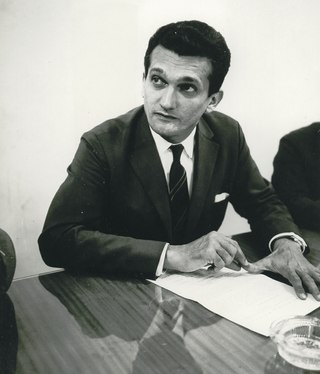
Celso Monteiro Furtado was a Brazilian economist and one of the most distinguished intellectuals of the 20th century. His work focuses on development and underdevelopment and on the persistence of poverty in peripheral countries throughout the world. He is viewed, along with Raúl Prebisch, as one of the main formulators of economic structuralism, an economics school that is largely identified with CEPAL, which achieved prominence in Latin America and other developing regions during the 1960s and 1970s and sought to stimulate economic development through governmental intervention, largely inspired on the views of John Maynard Keynes. As a politician, Furtado was appointed Minister of Planning and Minister of Culture.
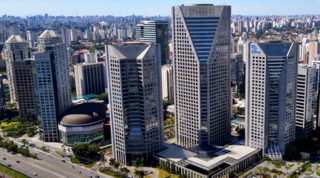
The economy of South America comprises approximately 434 million people living in twelve nations and three territories. It encompasses 6 percent of the world's population.

Itajubá is a municipality in southeastern Minas Gerais state of the Federative Republic of Brazil. It lies in a valley by the Sapucaí river and has terrain elevations ranging from 827 to 1500 metres, occupying an area of 290.45 km2 (112.14 mi2), with a population of 97,334 people. Neighboring the city are the mountain slopes of the Serra da Mantiqueira range. The climate sees heavy rain in the summer months with dry weather in the winter.

The Trans-Amazonian Highway was introduced on September 27, 1972. It is 4,000 km long, making it the third longest highway in Brazil. It runs through the Amazon forest and the Brazilian states of Paraíba, Ceará, Piauí, Maranhão, Tocantins, Pará and Amazonas, from the proximities of Saboeiro up until the town of Lábrea.

Brazilian industry has its earliest origin in workshops dating from the beginning of the 19th century. Most of the country's industrial establishments appeared in the Brazilian southeast, and, according to the Commerce, Agriculture, Factories and Navigation Joint, 77 establishments registered between 1808 and 1840 were classified as "factories" or "manufacturers". However, most, about 56 establishments, would be considered workshops by today's standards, directed toward the production of soap and tallow candles, snuff, spinning and weaving, foods, melting of iron and metals, wool and silk, amongst others. They used both slaves and free laborers.
A creative economy is based on people's use of their creative imagination to increase an idea's value. John Howkins developed the concept in 2001 to describe economic systems where value is based on novel imaginative qualities rather than the traditional resources of land, labour and capital.: Compared to creative industries, which are limited to specific sectors, the term is used to describe creativity throughout a whole economy.
Euvaldo Lodi Institute of Rio de Janeiro is the equivalent of the Brazilian Euvaldo Lodi Institute, created by the National Confederation of Industry along with the Industry Social Service (SESI) and the National Industrial Training Service in 1969. Except it only covers Rio de Janeiro state, instead of all the Brazilian territory.
The Industry Social Service of the State of Rio de Janeiro comprehends SESI's work in Rio de Janeiro state. The institution focuses in improving work environments, quality of life and education levels of collaborators from Rio de Janeiro's enterprises. Through programs and mobile units, it carries out actions related to health, education, sports, leisure, culture, occupational health, work safety and environmental protection. These activities are aimed at workers and companies, as much as to society in general. SENAI Rio's history is parallel to the Brazilian industrial development and its designation accompanies Rio de Janeiro's changes, as when it became a capital and was renamed Guanabara state.
The Industry Federation of the State of Rio de Janeiro (FIRJAN) is a Brazilian industrial federation from the state of Rio de Janeiro that acts as a representative of the state's industries at municipal, state and national levels. The organization, one of the five that comprehend the FIRJAN System, also promotes debates and produces researches, studies and projects aiming Rio de Janeiro's sustainable development. The provision of services to companies affiliated to it targets the industrial, social and economic growth of Rio de Janeiro state.

Rose Marie Muraro was a Brazilian sociologist, writer, intellectual and feminist. Born nearly blind, she was the author of over 40 books and also served as publisher and director of Vozes.
FIRJAN System is a network of private nonprofit organizations with more than ten thousand associates. Its mission is to promote business competitiveness, education and quality of life of industrial workers and the whole society, in the state of Rio de Janeiro. FIRJAN System consists of five institutions that work in an integrated manner for the growth of the industry of RJ. Together, FIRJAN, Industrial Center of Rio de Janeiro (CIRJ), Industry Social Service of the State of Rio de Janeiro, National Industrial Training Service of the State of Rio de Janeiro and Euvaldo Lodi Institute of Rio de Janeiro promote actions in economic, political and social levels to ensure a prominent position to the state on the national scenery. Today, all institutions act as service providers to enterprises and society.

Maria da Conceição Tavares is a Portuguese naturalized Brazilian economist. She is a full professor at the State University of Campinas (Unicamp) and professor emeritus of the Federal University of Rio de Janeiro (UFRJ). Her students have included the former president of Brazil, Dilma Rousseff. Tavares is affiliated with the Workers' Party, and she was a Federal Deputy representing the state of Rio de Janeiro between 1995 and 1999. Left-wing focused, she is the author of several books on Brazil's economic development as well as numerous journal articles.

From mid-2014 onward, Brazil experienced a severe economic crisis. The country's Gross Domestic Product (GDP) fell by 3.5% in 2015 and 3.3% in 2016, after which a small economic recovery began. That recovery continued until 2020, when the COVID-19 pandemic began to impact the economy again.
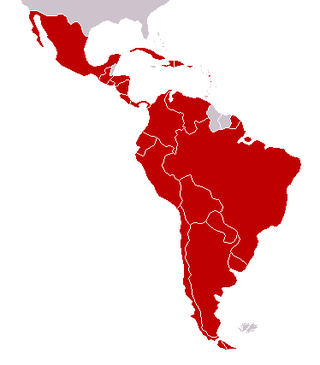
Latin America as a region has multiple nation-states, with varying levels of economic complexity. The Latin American economy is an export-based economy consisting of individual countries in the geographical regions of North America, Central America, South America, and the Caribbean. The socioeconomic patterns of what is now called Latin America were set in the colonial era when the region was controlled by the Spanish and Portuguese empires. Up until independence in the early nineteenth century, colonial Latin American regional economies thrived and worked things out. Many parts of the region had favorable factor endowments of deposits of precious metals, mainly silver, or tropical climatic conditions and locations near coasts that allowed for the development of cane sugar plantations. In the nineteenth century following independence, many economies of Latin America declined. In the late nineteenth century, much of Latin America was integrated into the world economy as an exporter of commodities. Foreign capital investment, construction of infrastructure, such as railroads, growth in the labor sector with immigration from abroad, strengthening of institutions, and expansion of education aided industrial growth and economic expansion. A number of regions have thriving economies, but "poverty and inequality have been deeply rooted in Latin American societies since the early colonial era."
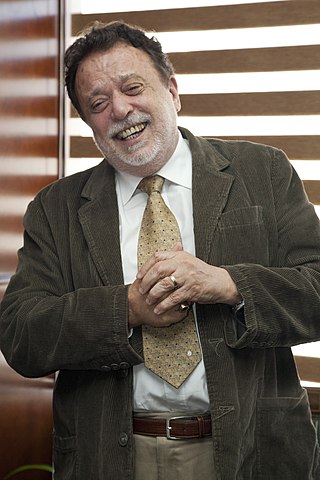
Theotônio dos Santos Junior was a Brazilian economist. He was one of the formulators of the Dependency Theory and supported the World-System theory.
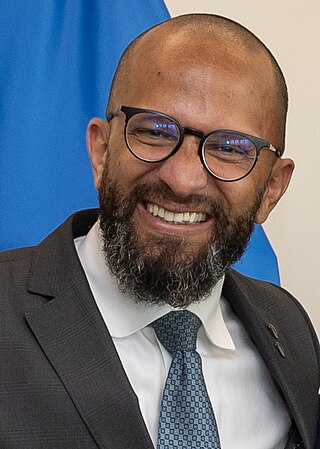
Abraão Vicente is Cape Verdean politician currently serving as both Minister of Culture and Creative Industries and Minister of the Sea. Vicente is a sociologist, painter and self-taught photographer.
References
- 1 2 "Conheça a economia criativa e veja 5 dicas para empreender na área". Coldibeli, Larissa - UOL Economia (07/02/2013). Retrieved 15 April 2014.
- ↑ "Brasil possui imenso potencial no mercado da economia criativa (in Globo Ecologia)". Rede Globo de Televisão (14/07/2012). Retrieved 15 April 2014.
- 1 2 3 4 5 "Indústria Criativa - Mapeamento da Indústria Criativa no Brasil (PDF - 1,85 MB)" (PDF). FIRJAN, Sistema (2012). Archived from the original (PDF) on 10 August 2013. Retrieved 16 December 2013.
- ↑ Restrepo, Márquez, Felipe Buitrago, Iván Duque (2013). "The Orange Economy • An Infinite Opportunity" (PDF). Inter-American Development Bank. Archived (PDF) from the original on 2020-11-24. Retrieved 29 December 2021.
{{cite web}}: CS1 maint: multiple names: authors list (link) - 1 2 Instituto Nacional da Propriedade Industrial (March 2021). "Setores Intensivos em Direitos de Propriedade Intelectual na Economia Brasileira" (PDF). Government of Brazil. Archived (PDF) from the original on 2021-12-29. Retrieved 29 December 2021.
- 1 2 3 Grupo Interministerial de Propriedade Intelectual. "Estratégia Nacional de Propriedade Intelectual 2021-2030" (PDF). Government of Brazil. Archived (PDF) from the original on 2020-12-12. Retrieved 29 December 2021.
- ↑ "Classificação Brasileira de Ocupações". Ministério do Trabalho e Emprego. Retrieved 16 December 2013.
- 1 2 "Creative Economy Report 2008: the challenge of assessing the creative economy (PDF - 2,54 MB)" (PDF). Unctad. 2008. Retrieved 26 March 2014.
- ↑ "A evolução do conceito de "Indústrias Criativas" no tempo" . Retrieved 14 April 2014.
- ↑ "Relatório de Economia Criativa 2010 (PDF)" (PDF). Nações Unidas. Archived from the original (PDF) on 15 April 2014. Retrieved 14 April 2014.
- ↑ "The Economic Performance of Copyright-Based Industries". WIPO. Archived from the original on 2013-07-16. Retrieved 29 December 2021.
- ↑ "Decreto Nº 7.743, de 31 de maio de 2012". Presidência da República do Brasil (31/05/2012). Retrieved 15 April 2014.
- ↑ "Economia Criativa". Ministério da Cultura do Brasil. Archived from the original on 1 June 2014. Retrieved 15 April 2014.
- ↑ "Brasil avança em criatividade" (PDF). Brasil Econômico (05/12/2011). Archived from the original (PDF) on 16 April 2014. Retrieved 15 April 2014.
- 1 2 "Planejando um Brasil criativo" (PDF). Brasil Econômico (05/12/2011). Archived from the original (PDF) on 16 April 2014. Retrieved 15 April 2014.
- ↑ "Economia criativa para o desenvolvimento (in Plano da Secretaria da Economia Criativa)" (PDF). Ministério da Cultura. Archived from the original (PDF) on 2016-09-20. Retrieved 2017-01-20.
- ↑ "Economia criativa:cultura e sustentabilidade (in Globo Ecologia)". Rede Globo de Televisão (14/07/2012). Retrieved 15 April 2014.[ permanent dead link ]
- ↑ Institui a Estratégia Nacional de Propriedade Intelectual. "DECRETO Nº 10.886, DE 7 DE DEZEMBRO DE 2021". Government of Brazil. Archived from the original on 2021-12-29. Retrieved 29 December 2021.
- ↑ Divisão de Pesquisa e Estatística. "Onde tem Indústria Criativa, tem Firjan". Firjan. Archived from the original on 2015-10-11. Retrieved 29 Dec 2021.
- ↑ ESTUDOS E PESQUISAS, AMBIENTE SOCIOECONÔMICO (February 2019). "Mapeamento da Indústria Criativa no Brasil" (PDF). Firjan Senai. Archived (PDF) from the original on 2020-09-11. Retrieved 29 Dec 2021.
- ↑ "Propriedade Intelectual, Governo do Brasil". Governo do Brasil. Archived from the original on 2021-06-10. Retrieved 29 December 2021.